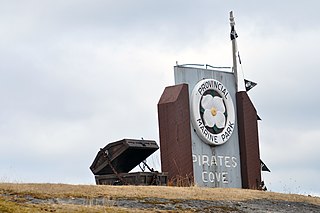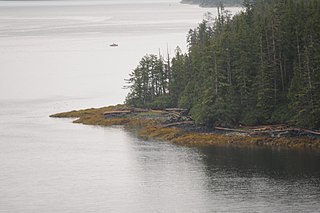Related Research Articles

Knight Inlet is one of the principal inlets of the British Columbia Coast, and the largest of the major inlets in the southern part of the Coast. It is fifth in sequence of the great saltwater inlets north from the 49th parallel near Vancouver, but it is the first whose outflow points away from the Strait of Georgia, opening into Queen Charlotte Strait at the Kwakwakaʼwakw community of Memkumlis on Village Island.
Dean Channel is the upper end of one of the longest inlets of the British Columbia Coast, 105 km (65.2 mi) from its head at the mouth of the Kimsquit River. The Dean River, one of the main rivers of the Coast Mountains, enters Dean Channel about 9.5 km (5.9 mi) below the head of the inlet, at the community of Kimsquit.

North Bentinck Arm is a short inlet about 17 km (11 mi) in length in the Central Coast region of British Columbia, Canada. It is an arm of Burke Channel and is linked via that waterway and Labouchere Channel to Dean Channel, which is one of the largest inlets of the BC Coast.

Harewood is the name of a lake and a plain of the Canadian province of British Columbia. It is located in Nanaimo, on the east coast of Vancouver Island. Its geographical coordinates are 49°08′N123°57′W The name has been in use since at least 1913, when Harewood referred to a small mining village in the area, no longer existing, having been overtaken by Nanaimo. The mine was owned in part by the seventh son of Henry Lascelles, 3rd Earl of Harewood who served on the BC coast as captain of the gunboat HMS Forward and set up the Harewood Coal Mining Company to work deposits he acquired.

De Courcy Island is one of the Gulf Islands of the coast of southwestern British Columbia, Canada, located between the Pylades and Stuart Channels approximately 16 km (9.9 mi) southeast of Nanaimo and approximately 38 km (24 mi) west of Vancouver.
King Island is an island on the Coast of the Canadian province of British Columbia. It is located south of Dean Channel and about 20 kilometres (12 mi) east of Bella Bella. A number of other islands separate King Island from the open sea of Queen Charlotte Sound.

Namu is a small fishing port, former cannery town and First Nations community on the coast of British Columbia, Canada. It is located about 95 km (59.0 mi) southwest of Bella Coola or 35 km (21.7 mi) SSE of Bella Bella, on the mainland shore of the Inside Passage ferry route directly opposite Hunter Island, and just south of the opening of Burke Channel and King Island. The community's harbour is named Namu Harbour, and a large lake just inland is Namu Lake, which lies in the short drainage basin of the 15 km Namu River, immediately east of which is the small but rugged Namu Range.

Milbanke Sound is a sound on the coast of the Canadian province of British Columbia.

Campania Island is an island on the coast of the Canadian province of British Columbia. It is located south of Prince Rupert, east across Hecate Strait from Haida Gwaii. To its west, across Estevan Sound, is the Estevan Group archipelago. Banks Island lies to the northwest, across Nepean Sound; and Pitt Island to the north, across Otter Channel. To the northeast, across Squally Channel, is Gil Island, and to the east is Princess Royal Island, across Campania Sound. To the south of Campania Island is Caamaño Sound, beyond which is Aristazabal Island.
South Bentinck Arm is a 40 km (25 mi) long side-inlet of Dean Channel in the Central Coast region of British Columbia, Canada. At the north end of the arm it meets the North Bentinck Arm and then the Dean Channel before flowing into the Burke Channel.

Fitz Hugh Sound, sometimes spelled Fitzhugh Sound, is a sound on the British Columbia Coast of Canada, located between Calvert Island and the mainland.

Laredo Sound is a sound on the Central Coast of British Columbia, Canada, located on the north side of Price Island. It is connected to Caamaño Sound via Laredo Channel, which runs between Princess Royal Island and Aristazabal Island.

Shearwater is a community in coastal British Columbia. It is located three miles from Old Bella Bella on Denny Island. It is in the territory of the Heiltsuk Nation.
Bull Harbour is a settlement in British Columbia, Canada.
Yeo Island is an island in the North Coast region of British Columbia, Canada. It is separated from the Don Peninsula to its west by Spiller Channel, and from the Coldwell Peninsula to its east by Bullock Channel. It was first charted and circumnavigated in 1793 by James Johnstone, one of George Vancouver's lieutenants during his 1791–95 expedition.
Roscoe Inlet is a fjord in the North Coast region of the Canadian province of British Columbia. It lies east of the Florence Peninsula, north of Johnson Channel. Its southern half was first charted in 1793 by George Vancouver and Spelman Swaine during their 1791-1795 expedition.
Cascade Inlet is a fjord in the North Coast region of the Canadian province of British Columbia. It extends northwest from Dean Channel. It was first charted in 1793 by George Vancouver and Spelman Swaine during their 1791-95 expedition. Vancouver named it "Cascade Channel" due to the great number of waterfalls he saw along its sides when he first explored the inlet.
Fisher Channel is a channel in the Central Coast region of the Canadian province of British Columbia. To its west are Hunter and Denny Islands, to its east King Island. It was first charted in 1793 by George Vancouver during his 1791-95 expedition. He named it "Fisher’s Channel" after "a much-respected friend" Reverend John Fisher.
Cunningham Island is an island in the North Coast region of the Canadian province of British Columbia. To its west is Chatfield Island, to its south Denny Island, and to its east the mainland. It was named by Captain Daniel Pender of the Beaver about 1866, after Thomas Cunningham, an early British Columbia settler. Its north and east coasts were first charted by George Vancouver in 1793.
Cousins Inlet is a fjord in the Central Coast region of the Canadian province of British Columbia. It extends north from Fisher Channel. At its head is the community of Ocean Falls. It was first charted in 1793 by George Vancouver and Spelman Swaine, during their 1791–1795 expedition to survey the Pacific Northwest.
References
- ↑ "Burke Channel". Geographical Names Data Base . Natural Resources Canada . Retrieved 2020-06-16.
- ↑ "Burke Channel". BC Geographical Names .
- ↑ Vancouver, George; Vancouver, John (1801). A voyage of discovery to the North Pacific ocean, and round the world. London: J. Stockdale.
- ↑ Akrigg, G.P.V.; Akrigg, Helen B. (1986), British Columbia Place Names (3rd, 1997 ed.), Vancouver: UBC Press, ISBN 0-7748-0636-2
52°09′14″N127°27′48″W / 52.15389°N 127.46333°W